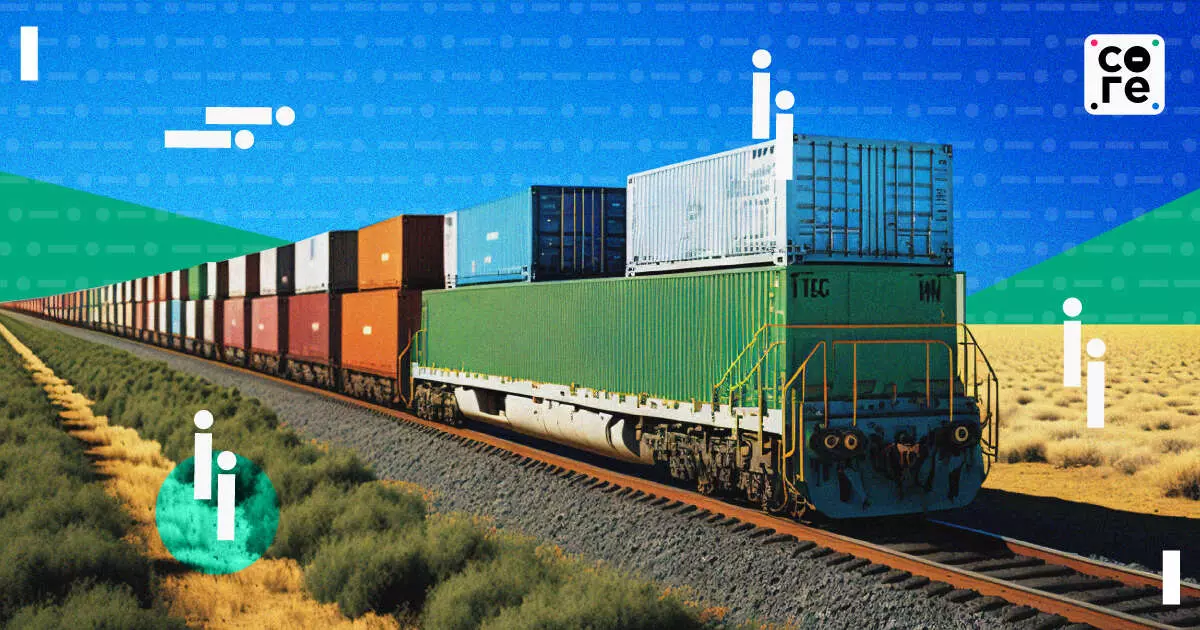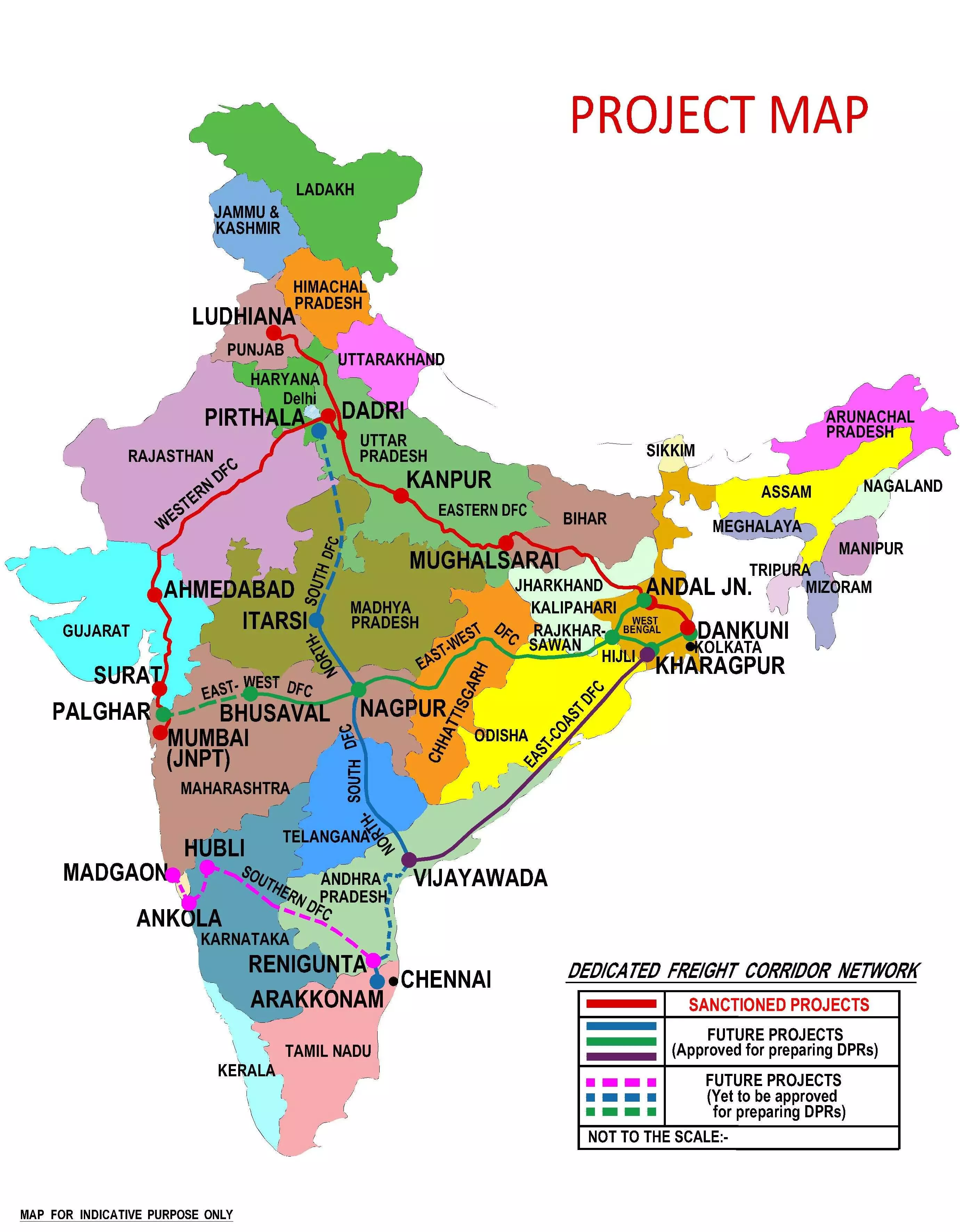
Land Acquisition Holds Up Completion Of Western Dedicated Freight Corridor
About 102 kilometres of an incomplete section that stretches till the JNPT is expected to be completed by December 2025.

The western side of the Dedicated Freight Corridor (DFC) project, also known as the Western Dedicated Freight Corridor (WDFC), still has approximately 100 kilometres of track lying unfinished.
First announced almost two decades ago in a budget speech in 2005, the dedicated freight corridors were supposed to be a boon for India’s logistics sector. The WDFC, which stretches from Dadri in Uttar Pradesh to Jawaharlal Nehru Port Trust (JNPT) in Mumbai, spans 1,468 kilometres and goes through the states of Uttar Pradesh, Haryana, Rajasthan, Gujarat and Maharashtra.
While the Eastern Dedicated Freight Corridor (EDFC) is fully operational, the WDFC still has 102 kilometres pending. This incomplete section runs from Vaitarna in Maharashtra’s Palghar district to JNPT and one of the major reasons for delay is the land acquisition procedure.
Completion is now expected by December 2025.
“Approximately 3000 project affected persons were living between Vaitarna and JNPT on an encroached land. Although these residents were not the legal owners, they lived in slums and required compensation for relocation. This issue impacted three districts: Raigad, Palghar, and Thane,” a spokesperson from Dedicated Freight Corridor Corporation of India (DFCCIL) told The Core.
Typically families who have to relocate due to land being acquired for infrastructure projects have to be compensated under The Right to Fair Compensation a...
The western side of the Dedicated Freight Corridor (DFC) project, also known as the Western Dedicated Freight Corridor (WDFC), still has approximately 100 kilometres of track lying unfinished.
First announced almost two decades ago in a budget speech in 2005, the dedicated freight corridors were supposed to be a boon for India’s logistics sector. The WDFC, which stretches from Dadri in Uttar Pradesh to Jawaharlal Nehru Port Trust (JNPT) in Mumbai, spans 1,468 kilometres and goes through the states of Uttar Pradesh, Haryana, Rajasthan, Gujarat and Maharashtra.
While the Eastern Dedicated Freight Corridor (EDFC) is fully operational, the WDFC still has 102 kilometres pending. This incomplete section runs from Vaitarna in Maharashtra’s Palghar district to JNPT and one of the major reasons for delay is the land acquisition procedure.
Completion is now expected by December 2025.
“Approximately 3000 project affected persons were living between Vaitarna and JNPT on an encroached land. Although these residents were not the legal owners, they lived in slums and required compensation for relocation. This issue impacted three districts: Raigad, Palghar, and Thane,” a spokesperson from Dedicated Freight Corridor Corporation of India (DFCCIL) told The Core.
Typically families who have to relocate due to land being acquired for infrastructure projects have to be compensated under The Right to Fair Compensation and Transparency in Land Acquisition, Rehabilitation and Resettlement Act, 2013 (commonly referred to as the Land Acquisition Act, 2013).
"We offered them a house but they wanted money in the form of compensation. So the compensation package was redesigned," the spokesperson explained.
This process took a decade.
The cost of the civil contract for the pending track, initially estimated at Rs 2800 to Rs 3000 crores, has now risen to approximately Rs 4000-5000 crores.
The project was first announced as part of the Railway Budget in 2005. By 2008 the areas and districts through which the railway track for the freight corridor would pass was decided.
Between 2008 to 2010, initial work, including land acquisition, began and was completed by 2014-2015. Changes in land laws in 2013 also contributed to delays. Therefore, the project effectively started around 2008-2009, following the final cabinet approval.
Cargo Diverted To Roadways
Since the track is incomplete between JNPT and Vaitarna, there is little traffic from JNPT on the DFC. Junctions have been built to connect Indian Railways trains from JNPT to the DFC track which are yet to be operational.
Currently, goods are moving from JNPT on the Indian Railways track as it has been historically. But because of capacity constraints, additional cargo is transported through roads.
“For example, previously, the railway capacity was to carry cargo that loads in 100 trains, but since there is demand for more capacity which may need about 120 trains, the additional cargo that might accommodate in about 20 trains is currently being transported via road,” said the spokesperson.
There is no fixed schedule for these trains to use the DFC as the decision is made based on present conditions. For example, if there is congestion at the New Gholvad junction, IR may choose to send the cargo on a DFC train.
The WDFC is primarily catering to the ports in Gujarat, including Kandla and Mundra, which connect through Palanpur, Sanand, and Mehsana (near Ahmedabad).
Why Are DFCs Crucial?
The EDFC plays a pivotal role in catering to the coal and mineral industries. This corridor has significantly bolstered coal supply chains, particularly benefiting regions such as Haryana, Delhi, the NCR area, and Uttar Pradesh.
“Currently, approximately 80-85% of freight vehicles have transitioned to utilizing the EDFC, with the North Central Railway network witnessing over 200 trains in operation daily,” Rajeev Roushan, Deputy General Manager (Mechanical) at DFCCIL told The Core.
On the other hand, the WDFC primarily focuses on handling export-import traffic from the ports and managing a considerable volume of container trains.
Additionally, numerous cement companies situated along the corridor rely on the WDFC for their logistical requirements.
“Notably, an innovative initiative involves the implementation of a truck on train system where loaded trucks are loaded onto the trains that help reach faster as compared to the road transportation” Roushan added.
This streamlined process ensures that milk tanks reach Rewari or the NCR area within a swift timeframe of less than 24 hours, effectively bypassing traditional road transport methods.
Amul and Amazon participate in the WDFC project. Amul transports milk by truck on train services, while Amazon ships a variety of items including household goods, kitchen appliances, apparel, fashion items, gadgets, and more.
Negotiating Land Acquisition
The DFCCIL was established in 2006 to oversee the ambitious project of creating a dedicated rail corridor for freight movement, separate from passenger traffic.
While the project was supposed to be completed in 10 years by 2015, another nine years have passed thanks to several roadblocks.
One of the critical obstacles has been acquiring the necessary land, which involves negotiating with local authorities, state governments, and landowners across the corridor's span of seven states and 72 districts.
This involves identifying landowners, compensating them, and resolving legal disputes, some involving unidentified landowners.
“Challenges like land acquisitions and financial closure took time. The project also faced delays because earlier the contract went to a Chinese company, but later it was discontinued,” Lalit Trivedi, a Railway expert, told The Core.
In Maharashtra, unauthorised colonies had to be removed, adding another layer of complexity. Each family was given a compensation ranging between Rs 15-20 lakhs.
As the project started in 2008-2009, the land acquisition challenges between Vaitarna and JNPT persisted for about 15 years and were finally resolved earlier this year.
Forest Clearances And Other Hurdles
Obtaining forest clearances proved difficult too, particularly where the track passes through wildlife sanctuaries or national parks, such as the Sanjay Gandhi National Park in Mumbai.
At the JNPT, there were contractual issues with the Tata Group which led to negotiations, further delaying the project. The Tatas had secured the contract to carry out civil construction along the 102-kilometre stretch. However, setbacks such as inadequate management and a lack of vigilance resulted in delays in the civil work, subsequently affecting other processes as well.
“We assisted with cash flow and provided necessary support, yet progress in this particular section was very poor. Over the last four years, we advanced the DFC project from 0% in early 2020 to nearly completing 96.4% by March 2024. However, despite efforts to address issues in the 102-kilometre track, the contractor's performance remained poor,” the spokesperson added.
Apart from land acquisition, the project also faced delays due to the terrain in the region.
“Geographically, the 102-kilometre stretch was challenging because from Vaitarna to Palghar, we had to navigate tunnels, bridges and more. If it were just a 102-kilometre track on plain terrain, construction would be much easier," said the spokesperson.
Furthermore, construction in the Rewari-Gurgaon up north faced annual bans from the National Pollution Control Board during winter months due to pollution concerns, contributing to the delays.
Urban development presented its own set of problems. Near Gurgaon, the track alignment unexpectedly intersected with an upcoming building due to unanticipated township developments.
This matter led to a court case where it was recognised that the DFC alignment was predetermined, but due to lack of communication, public interest favoured maintaining the track alignment.
“Changing it would have been far more costly than compensating the township developer. Although the track passes through only one tower, the developer argues that the proximity of the track affects the saleability of flats in the other towers, leading to ongoing compensation disputes," spokesperson said.

Uncertain Future Progress
The eastern and western DFC projects aim to expand the railway market share in partnership with the Indian Railways. The future corridors, some of which have been approved while others are still pending approval are North-South Corridor from Pirthala in Uttar Pradesh to Vijayawada in Andhra Pradesh, East-West Corridor from Palghar in Maharashtra to Andal Junction, Dankuni, and Kharagpur in West Bengal, Southern Corridor from Madgaon in Goa to Renigunta in Andhra Pradesh and East Coast Corridor from Vijayawada in Andhra Pradesh to Kharagpur in West Bengal.
When will these projects commence operations?
“From my understanding, the ministry is proceeding slowly on this matter. In the interim budget presented a few months ago by the Finance Minister, there was mention of mineral, energy, cement corridor, and port connectivity corridors, but no mention of the future projects of DFCs. This suggests a shift in planning priorities,” Trivedi said.
Earlier this year finance minister Nirmala Sitharaman had said during the Interim Budget 2024 that major economic railway corridor programmes will be implemented to enhance multi-modal connectivity under the PM Gati Shakti initiative to improve logistics efficiency and reduce costs.
She also stated that decongesting high-traffic corridors will enhance passenger train operations, increasing safety and travel speeds. Along with dedicated freight corridors, these economic corridor programs will accelerate GDP growth and lower logistics costs.
Change In Plan for EDFC
On the EDFC, the original plan was to extend the corridor from Ludhiana to Dankuni. However, the track has only been completed up to Sonnagar.
“The Indian Railways will handle the extension from Sonnagar to Dankuni. The reasons for these changes are not clear, but they were made during the EDFC's construction,” Roushan said.
Trivedi believes that there has been little concrete progress on the Sonnagar- Dankuni track.
“Whether it is Indian Railways or the DFC itself, progress has stalled, and the project remains in much the same state as it was a decade ago,” Trivedi added.
About 102 kilometres of an incomplete section that stretches till the JNPT is expected to be completed by December 2025.

